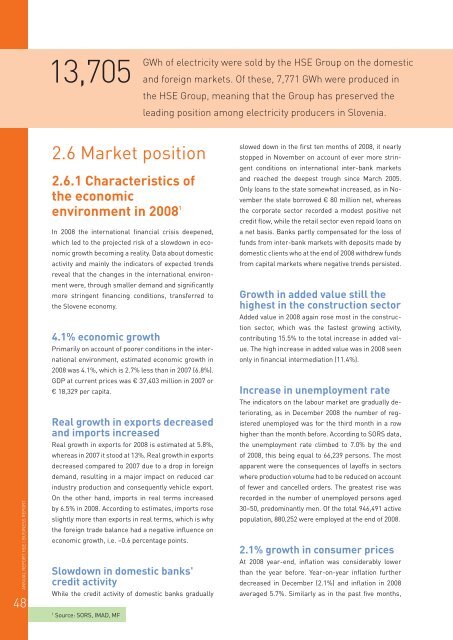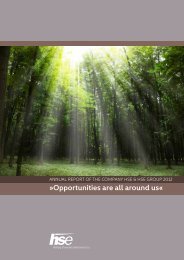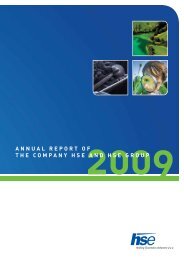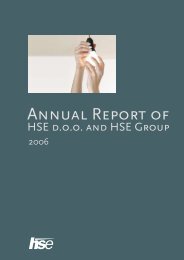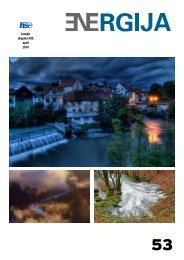ANNUAL REPORT - HSE
ANNUAL REPORT - HSE
ANNUAL REPORT - HSE
You also want an ePaper? Increase the reach of your titles
YUMPU automatically turns print PDFs into web optimized ePapers that Google loves.
13,705<br />
GWh of electricity were sold by the <strong>HSE</strong> Group on the domestic<br />
and foreign markets. Of these, 7,771 GWh were produced in<br />
the <strong>HSE</strong> Group, meaning that the Group has preserved the<br />
leading position among electricity producers in Slovenia.<br />
<strong>ANNUAL</strong> <strong>REPORT</strong> <strong>HSE</strong> | BUSINESS <strong>REPORT</strong><br />
48<br />
2.6 Market position<br />
2.6.1 Characteristics of<br />
the economic<br />
environment in 2008 1<br />
In 2008 the international financial crisis deepened,<br />
which led to the projected risk of a slowdown in economic<br />
growth becoming a reality. Data about domestic<br />
activity and mainly the indicators of expected trends<br />
reveal that the changes in the international environment<br />
were, through smaller demand and significantly<br />
more stringent financing conditions, transferred to<br />
the Slovene economy.<br />
4.1% economic growth<br />
Primarily on account of poorer conditions in the international<br />
environment, estimated economic growth in<br />
2008 was 4.1%, which is 2.7% less than in 2007 (6.8%).<br />
GDP at current prices was € 37,403 million in 2007 or<br />
€ 18,329 per capita.<br />
Real growth in exports decreased<br />
and imports increased<br />
Real growth in exports for 2008 is estimated at 5.8%,<br />
whereas in 2007 it stood at 13%. Real growth in exports<br />
decreased compared to 2007 due to a drop in foreign<br />
demand, resulting in a major impact on reduced car<br />
industry production and consequently vehicle export.<br />
On the other hand, imports in real terms increased<br />
by 6.5% in 2008. According to estimates, imports rose<br />
slightly more than exports in real terms, which is why<br />
the foreign trade balance had a negative influence on<br />
economic growth, i.e. –0.6 percentage points.<br />
Slowdown in domestic banks'<br />
credit activity<br />
While the credit activity of domestic banks gradually<br />
1<br />
Source: SORS, IMAD, MF<br />
slowed down in the first ten months of 2008, it nearly<br />
stopped in November on account of ever more stringent<br />
conditions on international inter-bank markets<br />
and reached the deepest trough since March 2005.<br />
Only loans to the state somewhat increased, as in November<br />
the state borrowed € 80 million net, whereas<br />
the corporate sector recorded a modest positive net<br />
credit flow, while the retail sector even repaid loans on<br />
a net basis. Banks partly compensated for the loss of<br />
funds from inter-bank markets with deposits made by<br />
domestic clients who at the end of 2008 withdrew funds<br />
from capital markets where negative trends persisted.<br />
Growth in added value still the<br />
highest in the construction sector<br />
Added value in 2008 again rose most in the construction<br />
sector, which was the fastest growing activity,<br />
contributing 15.5% to the total increase in added value.<br />
The high increase in added value was in 2008 seen<br />
only in financial intermediation (11.4%).<br />
Increase in unemployment rate<br />
The indicators on the labour market are gradually deteriorating,<br />
as in December 2008 the number of registered<br />
unemployed was for the third month in a row<br />
higher than the month before. According to SORS data,<br />
the unemployment rate climbed to 7.0% by the end<br />
of 2008, this being equal to 66,239 persons. The most<br />
apparent were the consequences of layoffs in sectors<br />
where production volume had to be reduced on account<br />
of fewer and cancelled orders. The greatest rise was<br />
recorded in the number of unemployed persons aged<br />
30–50, predominantly men. Of the total 946,491 active<br />
population, 880,252 were employed at the end of 2008.<br />
2.1% growth in consumer prices<br />
At 2008 year-end, inflation was considerably lower<br />
than the year before. Year-on-year inflation further<br />
decreased in December (2.1%) and inflation in 2008<br />
averaged 5.7%. Similarly as in the past five months,


